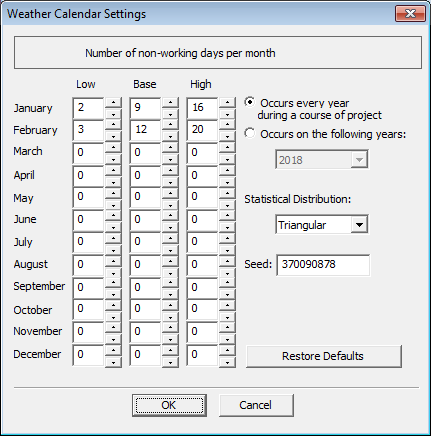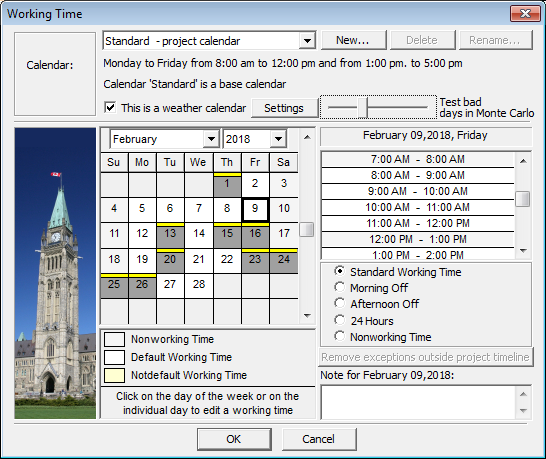Many projects have uncertainties with respect to the weather. Certain operations cannot be performed in bad weather. In construction and with oil & gas projects, weather is in fact one of the greatest risks. Weather uncertainties can be modeled in different ways, of which one uses a three-point estimate. A number of activities may have an estimate of between 3 to 10 days and this uncertainty can be attributed to the weather. Another way to model uncertainties is by using risk events. It is possible to define a risk, for example, apply “Delay due to weather” and assign it to the task and resource. This method is useful when you try to assess how weather would affect the fixed cost of a project.
One of the most common methods of modeling weather uncertainty is a weather calendar. This method can give you accurate results as long as you have historical data: how many non-working days this or a similar project experienced in the previous year. For example, you know that you have between 5 to 10 non-working days due to weather in January and between 6 to 12 non-working days in February. You would need to define a statistical distribution for non-working days for each particular month. Triangular distribution is most suitable for these purposes. The calendar with weather uncertainties can be applied to the particular tasks and resources. In theory, the weather calendar can become a project calendar. In most projects some activities can be performed during a bad weather day, although some cannot.
Subsequently, you would need to perform Monte Carlo simulations. On each iteration of Monte Carlo simulation the software would obtain a number of non-working days from the statistical distribution and select specific dates. For example, in the month of January the number of non-working days on the first iteration will be 7, specifically, January 3,5,6,15,20,25,26, and 31. For the next iteration the number of non-working days will be 5 and the particular dates will be different. This information will be used to calculate the finish times of each operation on the whole project. It is important to note, that if you use a weather calendar and don’t have other uncertainties, the task duration with the weather calendar will always be the same, but the finish time will change on each iteration.
The resulting analysis exhibits the statistical distribution of the entire project or a particular project milestone finish time. You can use weather calendars to generate risk adjusted project schedules.






